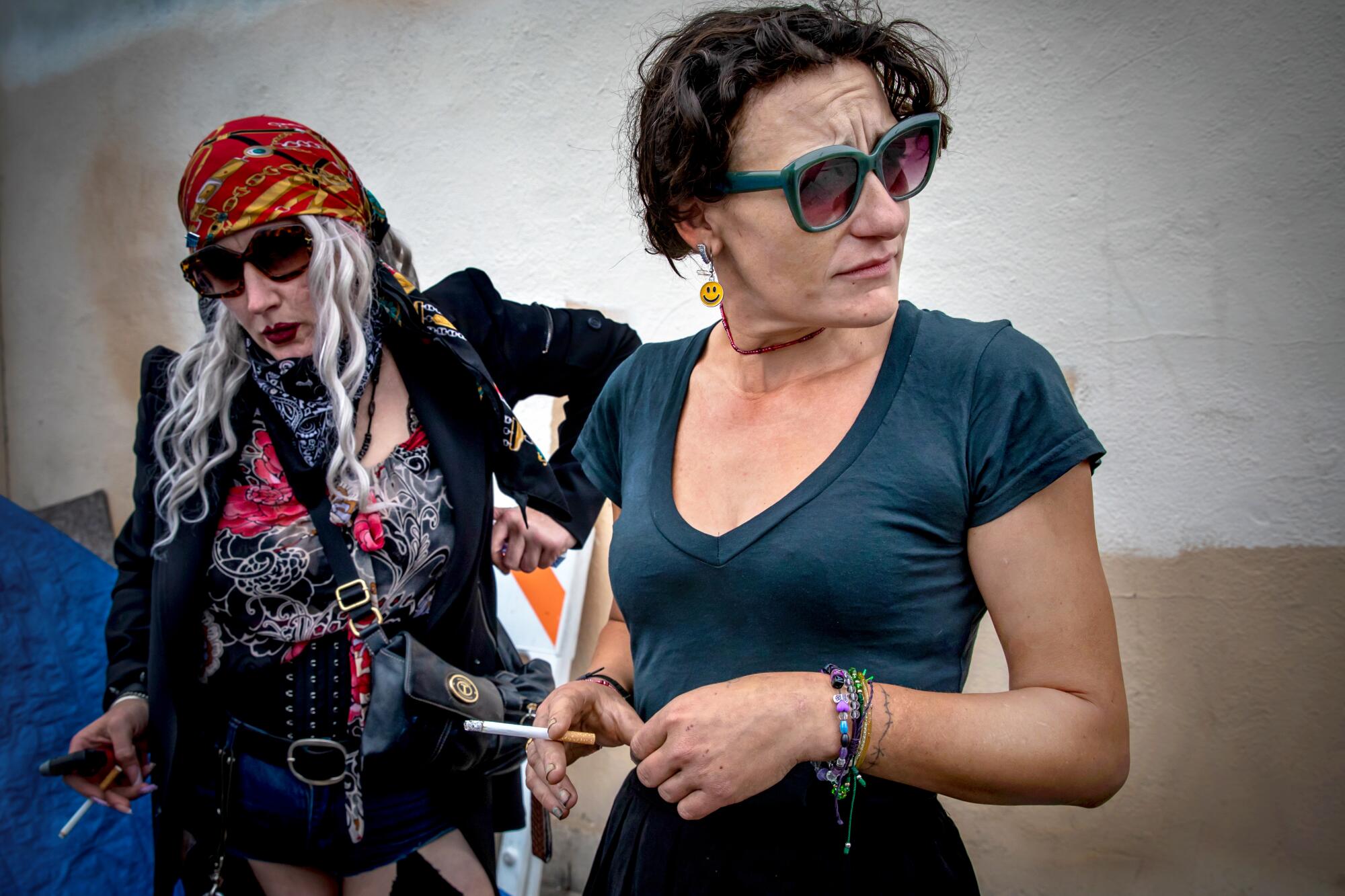
- Share via
Next to a row of tents covered with blue tarps on Skid Row, Jasmine Paredes watched a friend scribble a message on a lamppost with a pink Sharpie: L.A. — Fenty is #1 killa — may God help us all.
Paredes had recently lost two friends to fentanyl overdoses. She prevented a third death by performing CPR and administering Narcan, a nasal spray that can reverse the effects of opioids — one of nearly a dozen times she has brought someone back from the brink, she said.
She doesn’t use fentanyl herself, she said. But a few days ago, she took a hit from a glass pipe she thought was filled with meth that instead turned out to be the much more powerful drug.
“As soon as I exhaled, everything got really slow and dreamy,” said Paredes, 36, who lives in a tent in the flower district. “I was unconscious for two days. I later crawled across the street to my friend’s tent and slept for another two days.”
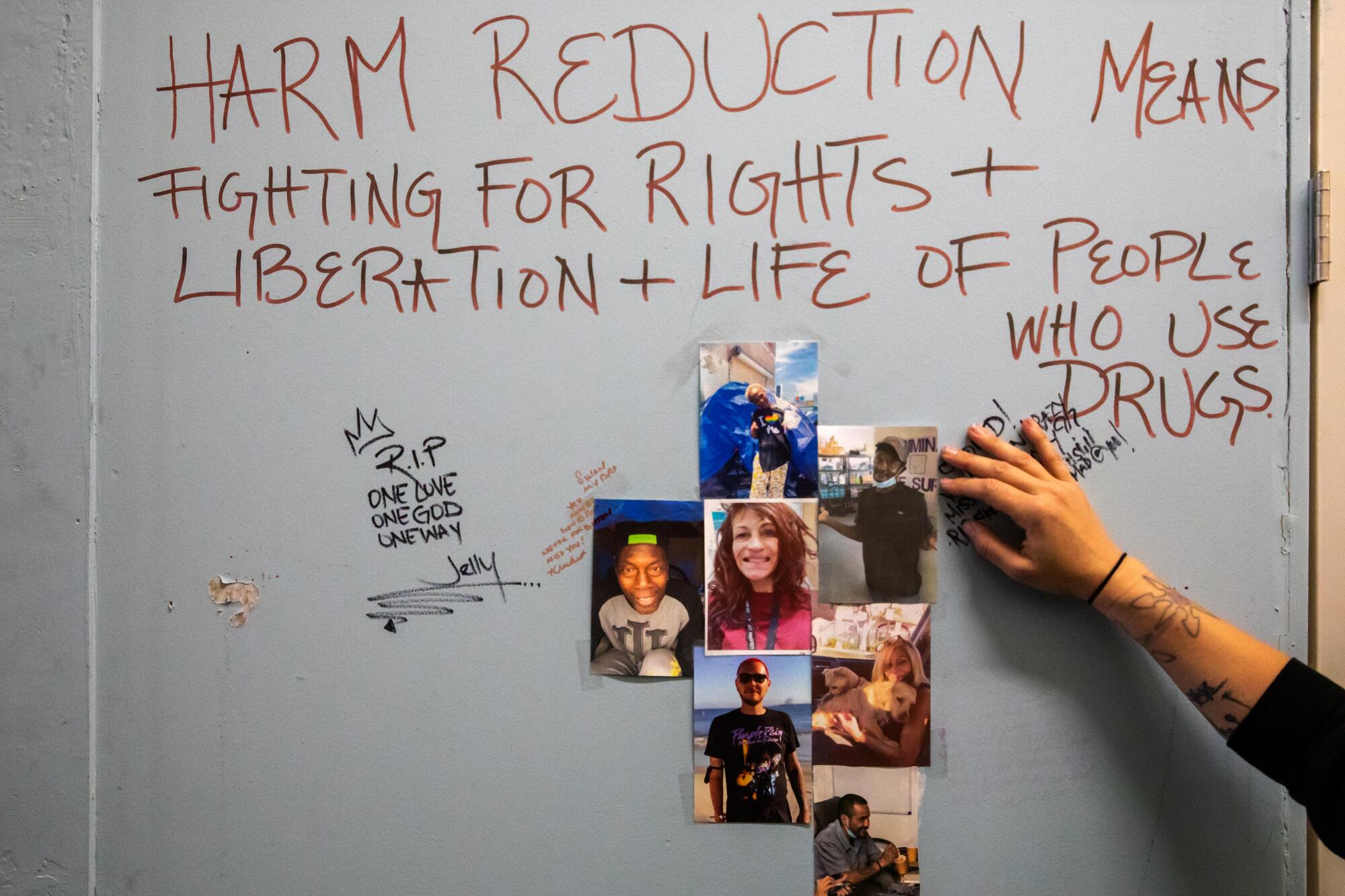
Here and in other homeless encampments around Los Angeles, life-and-death battles with fentanyl take place every day: hardened addicts revived after their hearts have stopped; people like Paredes who shared a pipe, not knowing what it contained; the loss of friend after friend.
Many have witnessed an overdose, suffered one themselves or helped save someone’s life. Narcan is nearly as common in tents as Tylenol is in medicine cabinets.
This is the reality behind numbers recently released by the L.A. County Public Health Department showing a surge in overdose deaths among homeless people, driven by the explosive rise of fentanyl.
Fentanyl, a synthetic opioid, was implicated in 58% of deadly overdoses among unhoused people in L.A. County in 2021 — nearly three times the percentage in 2019.
The overall death rate among people experiencing homelessness in the county increased 55% from 2019 to 2021.
The death rate surged 55% among people experiencing homelessness in L.A. County between 2019 and 2021, a markedly sharper increase than in the years before the COVID-19 pandemic.
On the streets, users say, fentanyl is more expensive than meth. It is so potent that even a trace amount in a pipe or several puffs of secondhand smoke can make someone pass out or become extremely ill, especially if they’ve never taken the drug before.
While no group has been untouched by fentanyl, the overdoses have hit unhoused people especially hard.
“On Skid Row, it’s a day-to-day crisis. It’s visible,” said Shoshanna Scholar, director of the harm reduction division at the Los Angeles County Health Services Department. “But it’s really a problem across the entire county.”
Standing at 6th and Crocker streets, Paredes said that to safely use meth, she usually sticks to a dealer whom she trusts not to sell her anything laced with fentanyl. After her accidental brush with the drug, she uses her own pipe and cleans it after anyone borrows it. Other drug users said they take similar precautions.
Paredes, who suffers from depression and anxiety, said she started using meth in high school. She was sober for years until her father died of liver cancer in 2017. Soon after, she lost her mother to uterine cancer. Her addiction caused her boyfriend to leave with their 3-year-old son, she said.
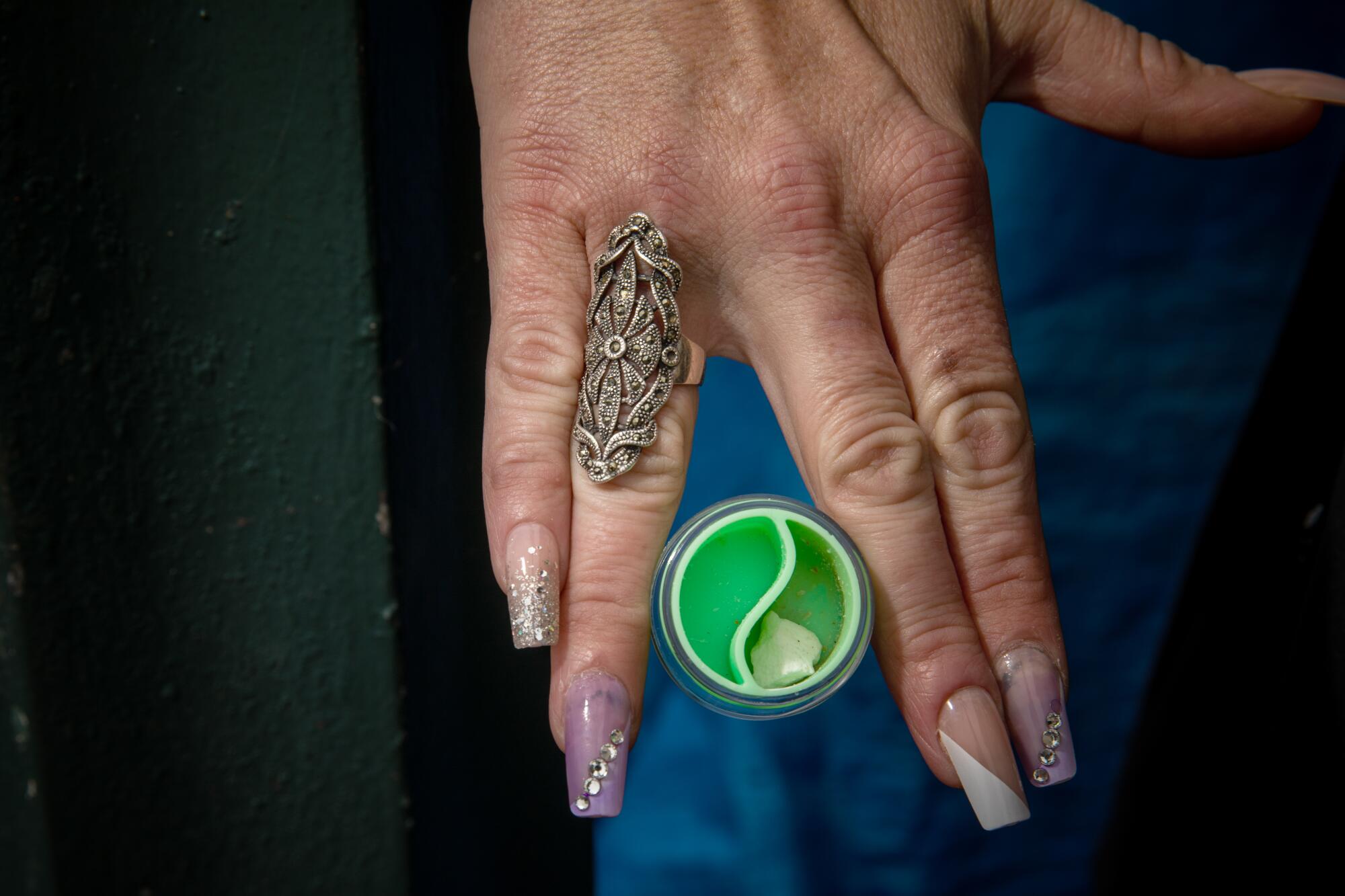
Paredes’ friend, who had just scrawled the plea to a higher power on the lamppost, uses fentanyl. The woman, who identified herself only as Karma, said she smokes the drug as often as every two hours to avoid the excruciating withdrawal pain.
She said a gram of fentanyl can cost $70, compared with $10 for the same amount of meth, and can last her up to two days, depending on its potency.
Nearby, several homeless people said that they, like Paredes, had experienced dire consequences from unintentional exposure to fentanyl.
Tanya Williams, 52, sat in her brown tent outside a small metal warehouse. In February, she said, she used someone’s glass pipe to smoke crack. She didn’t know it had fentanyl in it.
“As soon as I took a hit, I passed out,” she said.
People later told her they panicked after she stopped breathing and her skin turned blue. They dosed her with Narcan and called paramedics. On the way to the hospital, her heart stopped.
“When I woke up, there were eight or so doctors around me,” she said. “I started screaming, ‘Jesus, please don’t let me die!’”
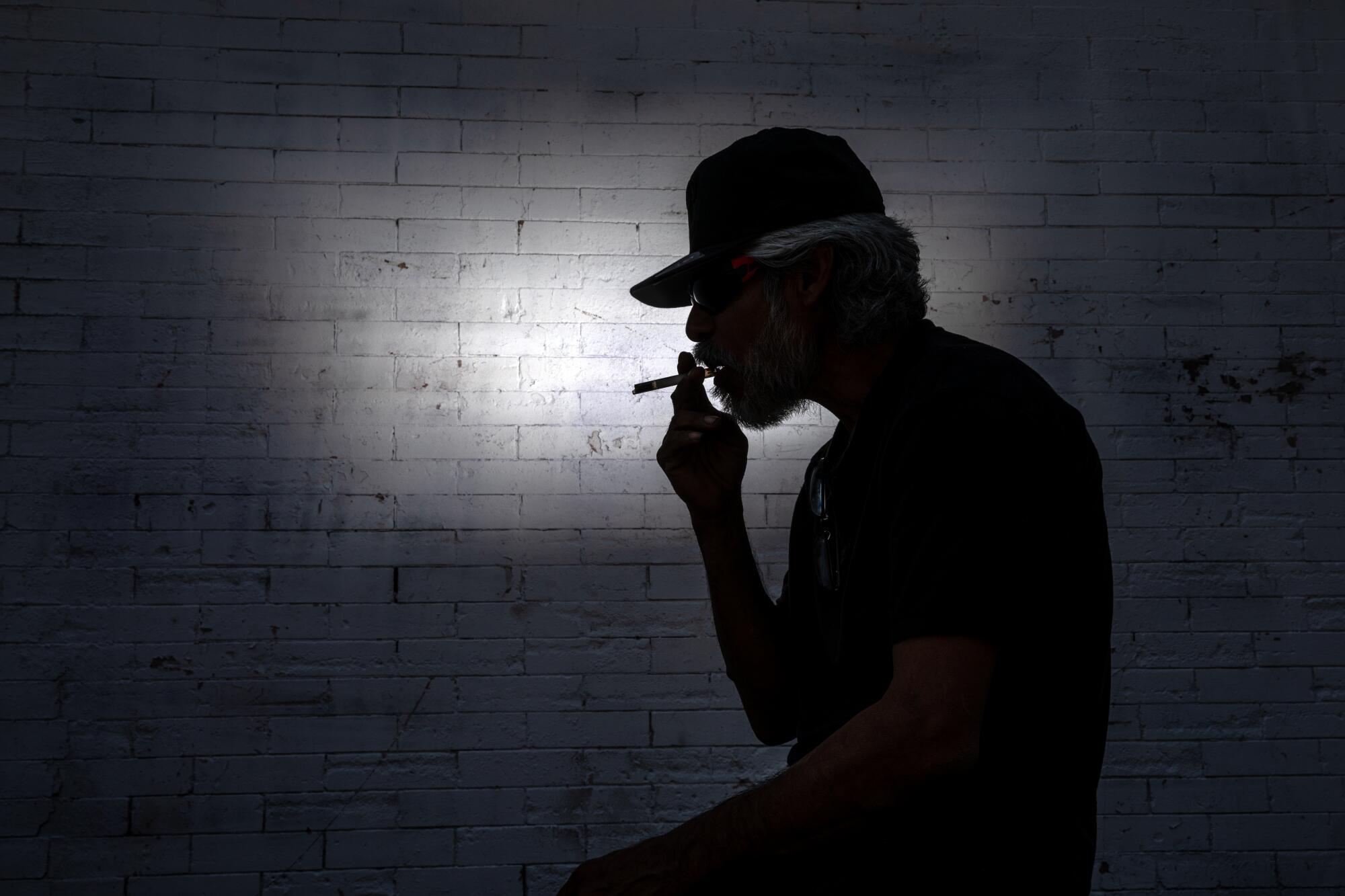
Williams suspects that either the crack she smoked was laced with fentanyl or the pipe contained fentanyl remnants, since its owner used the drug.
As she sat on an air mattress recounting the story, she began to cry. It was a reminder of how far she had fallen.
Williams said she spent 14 years in prison in her native Kansas on manslaughter charges; she was reluctant to discuss the details. She said that when she got out, she learned that her husband had fallen in love with her sister. She came to L.A. to be near her father, who later died of dementia. That led her to start using drugs again, she said.
In January, she was raped on Skid Row, she said.
“I want to go back to Kansas,” she said. “But I have so much anger toward my sister, I’m afraid I’ll do something.”
A block away, just outside the Fred Jordan Missions, Joe Hay said that a few months before, he was in a tent with a woman, smoking what he thought was crack. He started vomiting and passed out for hours.
“Two days later, I went to the doctor and told them what happened,” said Hay, 70. “The blood test showed I had traces of fentanyl.”
Roger, 57, who declined to give his last name, said he was in Boyle Heights in November with his girlfriend, a meth and fentanyl user. She blew smoke toward him several times, and he passed out.

“When I woke up, I was in my boxers and had a bag of ice under my neck,” he said. “My girlfriend was on the phone with the paramedics and told me I had overdosed.”
After that, he took a class on how to handle fentanyl overdoses. In February, after he and his girlfriend had finished buying crack, they saw a woman collapse on the sidewalk. Roger rubbed his knuckles against her sternum, as he had learned in the class. The woman swung her arm against his.
“We knew she was OK after that,” he said, adding that Narcan and CPR would have been the next step had she not reacted.
In East Hollywood, outside the LA Community Health Project — where unhoused people can receive clean needles, fentanyl test strips and Narcan, as well as referrals to health and housing services — Alex Taylor, 35, sat slumped on the sidewalk, occasionally nodding off.
The L.A. native said he became addicted to crystal meth at age 15. Almost a year ago, he shot up fentanyl and overdosed.
“It’s not my everyday drug, so it’s easy to get a bad bunch,” said Taylor. “I thought I’d kicked the bucket.”
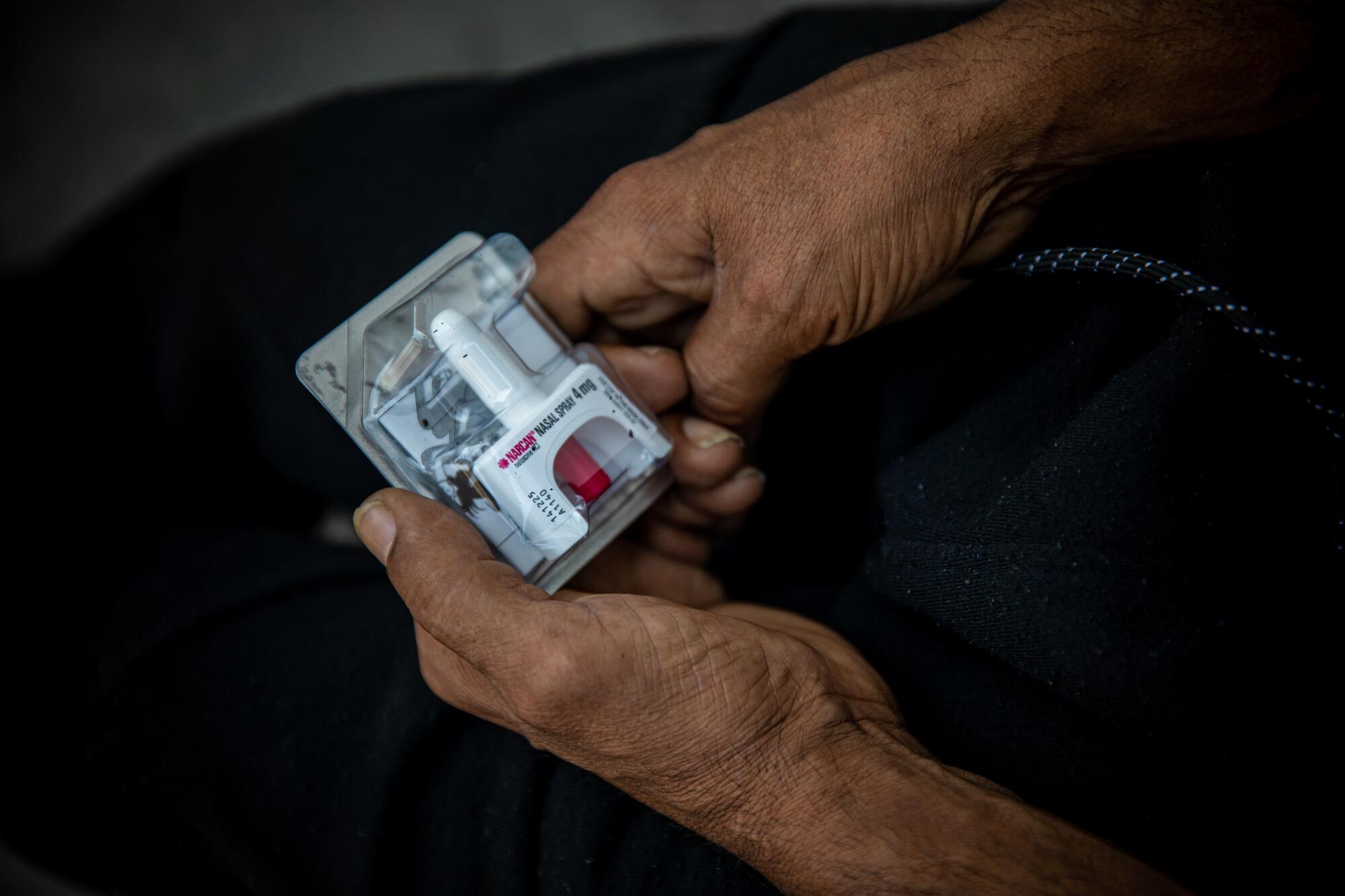
Someone gave him Narcan, but he had to be taken to the hospital by ambulance.
“It’s kind of easy to OD, but I didn’t care. Screw it,” he said.
Also outside the LA Community Health Project, Kevin Franklin, 19, said the nonprofit has helped him quit fentanyl, but he still uses meth.
Franklin, from Baltimore, said he got addicted to meth at age 12. His mother died of a heroin overdose, and his father shot himself in the head.
He arrived in L.A. on heroin, but it was hard to find any; fentanyl was cheaper and more available, he said. He overdosed multiple times.
“The fentanyl high — it’s much more intense, but your high falls off much faster,” he said. “And you’re like, ‘Oh, dammit, I need to go get more and more and more.’ Even while you are high, you’re thinking about how to get more fentanyl.”
The brushes with death from overdosing didn’t give him much pause.
“An addict doesn’t think that way. A $10 high, $20 high — that’s what they think,” he said.
Pipe handouts and other harm reduction can be a bridge to treatment, and cut infection and disease, including HIV. But pipes are controversial, not just in GOP circles but on Skid Row, a drug “recovery zone” that saw the worst of the crack epidemic.
Public health officials say they have been educating people about the dangers of fentanyl, distributing more Narcan and doubling down on drug treatment.
Community outreach groups have played a key role in getting Narcan to unhoused people. They’ve also helped provide clean syringes and places where users can test drugs to know what they are ingesting.
Soma Snakeoil is executive director of the Sidewalk Project, which operates a Skid Row drop-in center that focuses on the needs of women, especially those who use drugs or do sex work.
“People are saying they’re losing their friends,” Soma said. “There’s a lot of grief.”
The death rate surged 55% among people experiencing homelessness in L.A. County between 2019 and 2021, a markedly sharper increase than in the years before the COVID-19 pandemic.
On a wall inside the Sidewalk Project center are photos of seven volunteers and local people who died as recently as two months ago — half of them of fentanyl overdoses.
“We can’t do it every time, because there’s too many deaths, but if we’re close to people, we try to do something near their tent — put some flowers, candles or say some words,” Soma said.
She said that to save lives, there needs to be more drug testing, as well as more overdose prevention centers.
One positive trend is that unhoused people are increasingly smoking fentanyl rather than injecting it, according to county and community organizations. This reduces the risk of overdosing, because smokers usually ingest small amounts throughout the day, while intravenous users tend to take a whole hit.
At North Hollywood Recreation Center, a park ranger, who was not authorized to speak on the record, said overdose deaths have increased in recent years. Officials believe some of the deaths were fentanyl-related.
On a recent afternoon, there were only a few unhoused people in the park. Nearby, on the sidewalk, Gregory Brown was in the blue tent where he has lived for the last year.
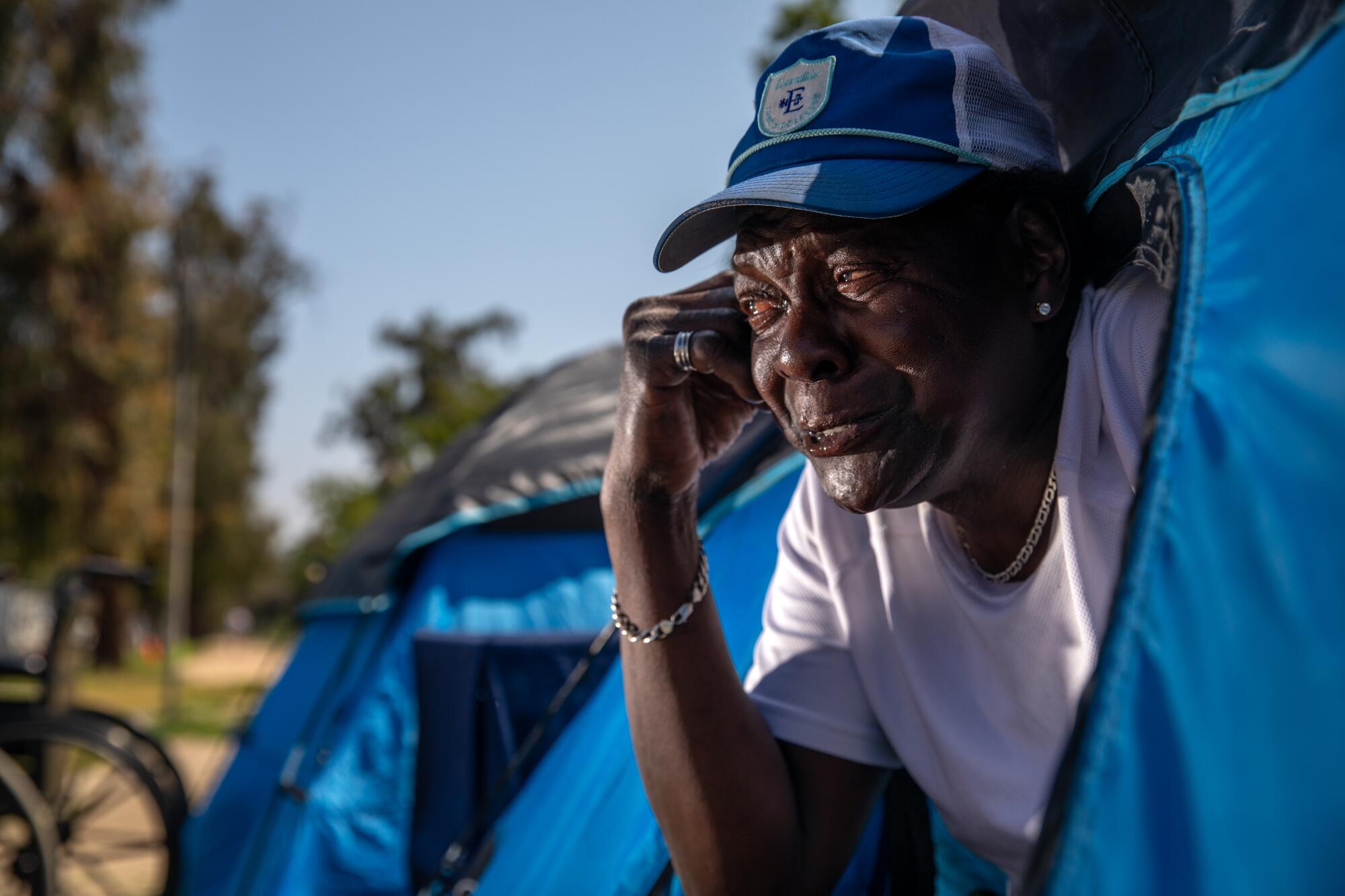
He said he found himself on the street after he caught his girlfriend of nine years cheating on him.
Three months ago, he was lying in his tent when he heard a man screaming, “She’s dying! She’s dying!”
Brown recalled rushing out of his tent, shirtless. A woman’s eyes were rolled back, and her lips were blue. He shouted for someone to call the paramedics.
“I kneeled down and said, ‘God, please, please, save another one.’”
He pumped her chest with his hands, then blew air into her mouth, he said. His tears fell on her face as he continued to perform CPR.
Eventually, the woman came back to life. She looked tired, he said, as if she had been awoken from a deep sleep.
Inside his tent afterward, he was still crying. He thought of his mother, who died nearly two decades ago, and how proud of him she would have been.
Reflecting on his role in saving the woman, he said: “I’m proud to say I did that, and I’d do it again.”
Times staff writer Gale Holland contributed to this report.
More to Read
Sign up for Essential California
The most important California stories and recommendations in your inbox every morning.
You may occasionally receive promotional content from the Los Angeles Times.

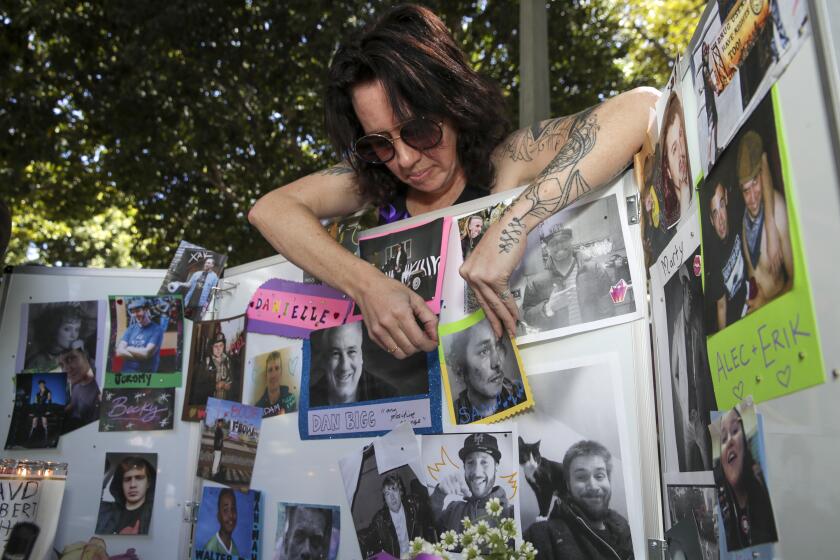
![Los Angeles, CA - May 19: Oscar Magana, 22, left, who struggles with mental problems but does not use drugs, sits in his tent as his step father, Johnny Roman, right, 58, who is addicted to meth, bipolar, manic depressive, and ADHD, puts bags of supplies for drug use in their tent encampment near Avalon Boulevard and East Florence Avenue in South Los Angeles Friday, May 19, 2023. The bags of supplies were distributed by a team from Homeless Outreach Program Integrated Care Systems [HOPICS] and includes drug pipes, overdose reversal nasal spray, fentanyl test strips, wipes and educational materials are aimed at preventing infection and disease, and saving them from the fentanyl death crisis. (Allen J. Schaben / Los Angeles Times)](https://ca-times.brightspotcdn.com/dims4/default/17c39ea/2147483647/strip/true/crop/3900x2600+0+168/resize/840x560!/quality/75/?url=https%3A%2F%2Fcalifornia-times-brightspot.s3.amazonaws.com%2Ff2%2Fc8%2Fa65d8e8f48afab4d760e8df4219e%2F1298639-me-soaring-fentanyl-deaths-16-ajs.jpg)














